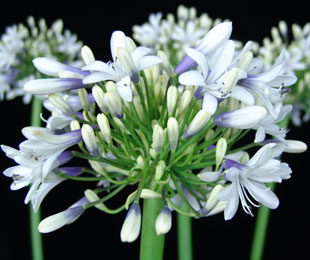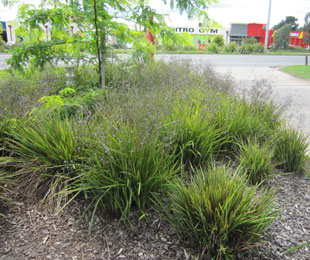Not all plants are equal when it comes to growing. Some fuss unless the soil, climate and care is just right where as others take a more laid back approach and give their best regardless of where, when or how they are planted. These plants deserve the title of 'bulletproof' and they are a good starting point for an easy-care garden.
The characteristics that make plants bulletproof are being free of pest and disease problems, having a good tolerance for soil extremes - both dry and wet conditions - and being both heat and cold tolerant. Bulletproof plants also establish quickly to form a strong root system, which is part of the plant's survival tactic.
Of course if a plant is too bulletproof, it may become a weed. To work in a garden situation and not become weedy, select plants that don't set copious seed, can't spread by rhizomes and don't become invasive.
Where to look
You can discover bulletproof plants growing in your local area. Look at plants that have survived in neglected gardens, thrive in the harsh environs of a roundabout planting or grow happily beside a footpath, fence or car park.
If you can't identify the particular plant yourself, get help from the local council authority or local garden centre, where experts should be able to identify not only the genus and species but also the cultivar. There are also state of the art apps available to help identify plants.
A word of - even bulletproof plants may take a hit if they are placed outside their usually broad comfort zone. Wet or poorly drained soils, extremes of cold or heat, salt spray and other factors can take their toll. So can poor planting or lack of good post-planting care just to get the plant established.
Having patrolled roundabouts, local parks and explored quite a few neglected gardens and landscapes looking for bulletproof plants, one plant breeder has developed and selected a range of tough, bulletproof selections. These plants, which are marketed by Ozbreed, can be used to set up the structure of the garden as hedges and edging plants, as groundcovers, massed shrubs for borders or accent plants to provide colour and seasonal interest.
Groundcover and accent plants
Groundcover and clumping plants not only fill in the gaps, they also suppress weeds and help unify a planting scheme. If you are after a low-care area, it is important to select plants that grow with little trouble. Here are bulletproof, low-care choices needing only an annual feed, water to establish and an occasional prune to encourage new growth.
High on the list of bulletproof groundcovers are gazanias. Once established, these cope with the hottest, driest places such beside a driveway or on an embankment. Double Gold™ gazania is a sterile form that won't become weedy.
Also growing without fuss are agapanthus plants. Blue and white Queen Mum™ agapanthus and 'Cloudy Days' are low-seed-yielding forms that flower well but produce none or little seed. Lomandra is another bulletproof choice. Tanika® lomandra is the most drought tolerant choice, whilst compact Shara™ lomandra is one of those rare plants that can handle the drought, as well as wet feet.
Handy to mass in a sweep are native dianellas. Of the many varieties of Dianella available the forms sold as Revelation® and Tasred® are tough choices. Tasred® dianella performs particularly well in our cooler, less humid southern states. Varieties of Dianella caerulea sold under the brand names of Little Jess™ and Lucia™ can be relied to grow everywhere.
If you've walked over sandbanks to the beach you will have noticed a plant commonly called pigface, the native succulent Carpobrotus glaucescens. It has fleshy leaves and large pinky purple flowers especially in spring and autumn. Well suited to coastal gardens it can be used as a groundcover in any extreme location. Look for the selected form Aussie Rambler™ carpobrotus, with larger flowers and a better ability to cope with heavy as well as sandy soils.
Shrubs for screens, hedges and accents
In a mass-planting situation such as a hedge or living screen, you need plants that grow uniformly and are dependable. Named varieties of any plant you select will have uniform growth and colour and grow to a known size. Selecting a cultivar that grows to the height you want reduces the need for constant pruning.
One of the most bulletproof of all plants is Indian hawthorn (Raphiolepis indica). This tough evergreen plant has shiny leaves and pretty apple-blossom-like spring flowers. It can be grown as a hedge or a single specimen in a pot. If you need a plant to take sun or shade, salt spray, heat and cold, Indian hawthorn can cope. The forms sold as Cosmic White™ and Cosmic Pink™ grow to around 50-150cm high and wide, produce little fruit (so don't become weedy) and can be pruned once a year to keep them in shape.
In recent years a number of evergreen native plants have been selected for use for hedges and screens including varieties of bottlebrush, lillypilly and westringia. These plants have interesting foliage, colourful and long-lasting flowers and, in the case of the lillypillies, decorative fruit. All are happy to be pruned.
For a native screen or windbreak to 3-6m look for a lillypilly such as Red Head™, Acmena smithii 'BWNRED' PBR which has colourful red-brown new growth, small white flowers and purple berries. It can be cut back hard to around 1.5m or left to reach its mature height of 6m. For wind swept, or sun-baked positions, including next to a Colorbond fence, you need a super reliable, long-lived plant such as the narrow, dense Slim™ callistemon, a long-flowering form.
For a lower-growing hedge with flowers consider the compact form of Callistemon viminalis sold as Better John™. Its blue-green foliage looks good year round but the red bottlebrush flowers add interest in spring. Better John™ callistemon grows 60-120cm high and 60-90cm wide in sun or part shade. Little pruning is needed as this plant has a naturally compact shape but it can be trimmed into a neat hedge every second year.
For a low hedge or a round, ball-shaped plant 30-40cm high and wide, look for Grey Box™ Westringia fruticosa 'WES04' PBR, which can be grown as an alternative to traditional box for either hedging or topiary. Like all bulletproof selections, Grey Box™ westringia takes sun or light shade, most soil types, tolerates frost and heat and can be grown in the ground or in a container. With regular pruning this variety can be easily maintained at around 20-30cm high and wide.
More information
Details about these plants can be found at Ozbreed.


